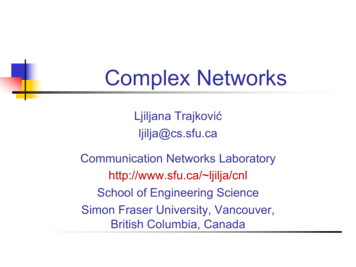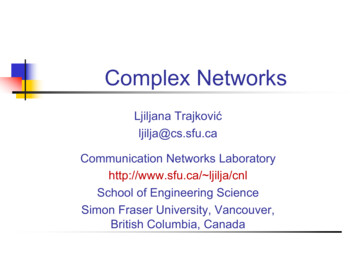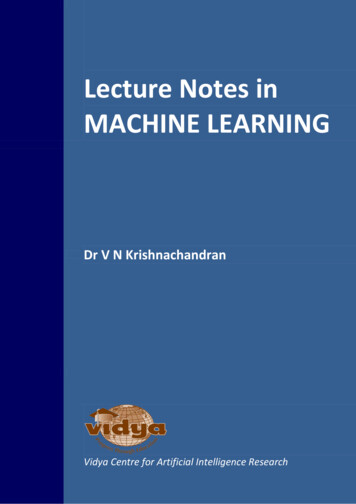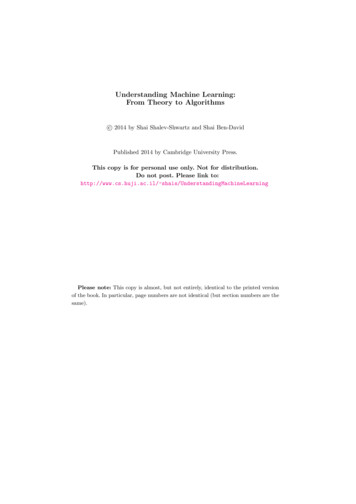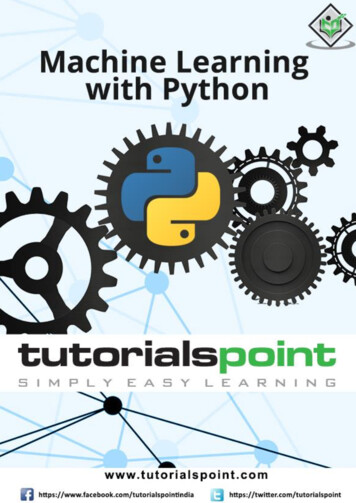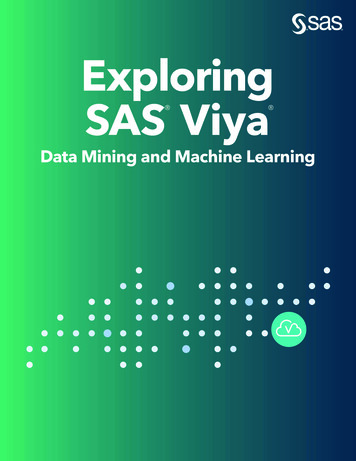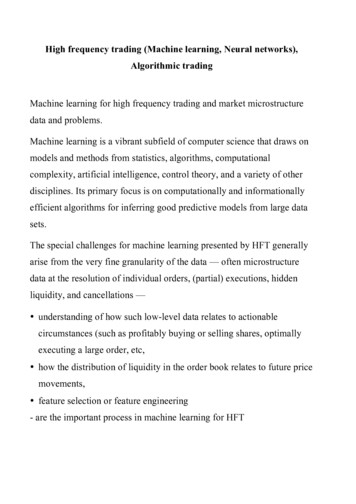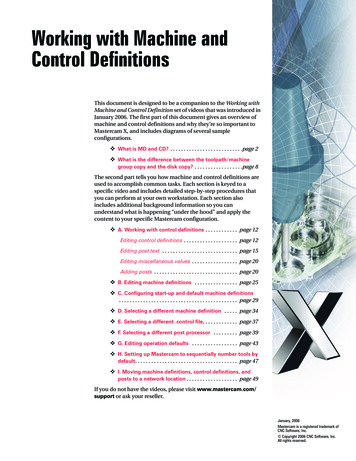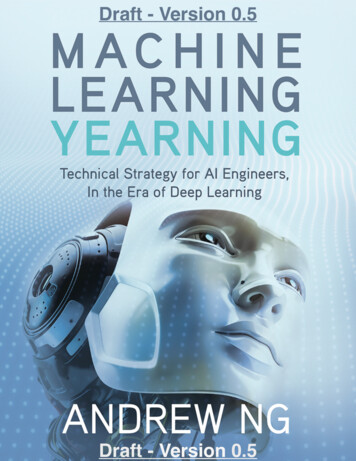
Transcription
Draft - Version 0.5Page !1Machine Learning Yearning-Draft V0.5Draft - Version 0.5Andrew Ng
Table of Contents (draft)Why Machine Learning Strategy .4How to use this book to help your team .6Prerequisites and Notation . 7Scale drives machine learning progress .8Your development and test sets .11Your dev and test sets should come from the same distribution .13How large do the dev/test sets need to be? .15Establish a single-number evaluation metric for your team to optimize .16Optimizing and satisficing metrics .18Having a dev set and metric speeds up iterations .20When to change dev/test sets and metrics .21Takeaways: Setting up development and test sets .23Build your first system quickly, then iterate .25Error analysis: Look at dev set examples to evaluate ideas .26Evaluate multiple ideas in parallel during error analysis .28If you have a large dev set, split it into two subsets, only one of which you look at .30How big should the Eyeball and Blackbox dev sets be? .32Takeaways: Basic error analysis .34Bias and Variance: The two big sources of error .36Examples of Bias and Variance. 38Comparing to the optimal error rate .39Addressing Bias and Variance .41Bias vs. Variance tradeoff .42Techniques for reducing avoidable bias .43Techniques for reducing Variance .44Error analysis on the training set .46Diagnosing bias and variance: Learning curves .48Plotting training error .50Interpreting learning curves: High bias .51Interpreting learning curves: Other cases . 53Plotting learning curves .55Why we compare to human-level performance .58How to define human-level performance .60Surpassing human-level performance .61Why train and test on different distributions.63Page !2Machine Learning Yearning-Draft V0.5Andrew Ng
Whether to use all your data .65Whether to include inconsistent data .67Weighting data .68Generalizing from the training set to the dev set .69Addressing Bias and Variance .71Addressing data mismatch .72Artificial data synthesis .73The Optimization Verification test .76General form of Optimization Verification test .78Reinforcement learning example .79The rise of end-to-end learning .82More end-to-end learning examples .84Pros and cons of end-to-end learning .86Learned sub-components .88Directly learning rich outputs .89Error Analysis by Parts .93Beyond supervised learning: What’s next? .94Building a superhero team - Get your teammates to read this .96Big picture .98Credits .99Page !3Machine Learning Yearning-Draft V0.5Andrew Ng
1Why Machine Learning StrategyMachine learning is the foundation of countless important applications, including websearch, email anti-spam, speech recognition, product recommendations, and more. I assumethat you or your team is working on a machine learning application, and that you want tomake rapid progress. This book will help you do so.Example: Building a cat picture startupSay you’re building a startup that will provide an endless stream of cat pictures to cat lovers.You use a neural network to build a computer vision system for detecting cats in pictures.But tragically, your learning algorithm’s accuracy is not yet good enough. You are undertremendous pressure to improve your cat detector. What do you do?Your team has a lot of ideas, such as: Get more data: Collect more pictures of cats. Collect a more diverse training set. For example, pictures of cats in unusual positions; catswith unusual coloration; pictures shot with a variety of camera settings; . Train the algorithm longer, by running more gradient descent iterations. Try a bigger neural network, with more layers/hidden units/parameters. Try a smaller neural network.Page !4Machine Learning Yearning-Draft V0.5Andrew Ng
Try adding regularization (such as L2 regularization). Change the neural network architecture (activation function, number of hidden units, etc.) If you choose well among these possible directions, you’ll build the leading cat pictureplatform, and lead your company to success. If you choose poorly, you might waste months.How do you proceed?This book will tell you how. Most machine learning problems leave clues that tell you what’suseful to try, and what’s not useful to try. Learning to read those clues will save you monthsor years of development time.Page !5Machine Learning Yearning-Draft V0.5Andrew Ng
2How to use this book to help your teamAfter finishing this book, you will have a deep understanding of how to set technicaldirection for a machine learning project.But your teammates might not understand why you’re recommending a particular direction.Perhaps you want your team to define a single-number evaluation metric, but they aren’tconvinced. How do you persuade them?That’s why I made the chapters short: So that you can print out and get your teammates toread just the 1-2 pages you need them to know.A few changes in prioritization can have a huge effect on your team’s productivity. By helpingyour team with a few such changes, I hope that you can become the superhero of your team!Page !6Machine Learning Yearning-Draft V0.5Andrew Ng
3Prerequisites and NotationIf you have taken a machine learning course such as my machine learning MOOC onCoursera, or if you have experience applying supervised learning, you will be able tounderstand this text.I assume you are familiar with supervised learning: Learning a function that maps from xto y, using labeled training examples (x,y). Supervised learning algorithms include linearregression, logistic regression, and neural networks. There are many forms of machinelearning, but the majority of machine learning’s practical value today is from supervisedlearning.I will frequently refer to neural networks (also known as “deep learning”). You’ll need only abasic understanding of what they are to follow this text.If you are not familiar with the concepts mentioned here, watch the first three weeks ofvideos in the Machine Learning course on Coursera at http://ml-class.orgPage !7Machine Learning Yearning-Draft V0.5Andrew Ng
4Scale drives machine learning progressMany of the ideas of deep learning (neural networks) have been around for decades. Why arethese ideas taking off now?Two of the biggest drivers of recent progress have been: Data availability. People are now spending more time on digital devices (laptops, mobiledevices). Their digital activities generate huge amounts of data that we can feed to ourlearning algorithms. Computational scale. We started just a few years ago to be able to train neural networksthat are big enough to take advantage of the huge datasets we now have.In detail, even as you accumulate more data, usually the performance of older learningalgorithms, such as logistic regression, “plateaus.” This means its learning curve “flattensout,” and the algorithm stops improving even as you give it more data:It was as if the older algorithms didn’t know what to do with all the data we now have.If you train a small neutral network (NN) on the same supervised learning task, you mightget slightly better performance:Page !8Machine Learning Yearning-Draft V0.5Andrew Ng
Here, by “Small NN” we mean a neural network with only a small number of hidden units/layers/parameters. Finally, if you train larger and larger neural networks, you can obtaineven better performance: 1Thus, you obtain the best performance when you (i) Train a very large neural network, sothat you are on the green curve above; (ii) Have a huge amount of data.Many other details such as neural network architecture are also important, and there hasbeen much innovation here. But one of the more reliable ways to improve an algorithm’sperformance today is still to (i) train a bigger network and (ii) get more data.The process of how to accomplish (i) and (ii) are surprisingly complex. This book will discussthe details at length. We will start with general strategies that are useful for both traditionallearning algorithms and neural networks, and build up to the most modern strategies forbuilding deep learning systems.1This diagram shows NNs doing better in the regime of small datasets. This effect is less consistentthan the effect of NNs doing well in the regime of huge datasets. In the small data regime, dependingon how the features are hand-engineered, traditional algorithms may or may not do better. Forexample, if you have 20 training examples, it might not matter much whether you use logisticregression or a neural network; the hand-engineering of features will have a bigger effect than thechoice of algorithm. But if you have 1 million examples, I would favor the neural network.Page !9Machine Learning Yearning-Draft V0.5Andrew Ng
Setting updevelopment andtest setsPage !10Machine Learning Yearning-Draft V0.5Andrew Ng
5Your development and test setsLets return to our earlier cat pictures example: You run a mobile app, and users areuploading pictures of many different things to your app. You want to automatically find thecat pictures.Your team gets a large training set by downloading pictures of cats (positive examples) andnon-cats (negative examples) off different websites. They split the dataset 70%/30% intotraining and test sets. Using this data, they build a cat detector that works well on thetraining and test sets.But when you deploy this classifier into the mobile app, you find that the performance isreally poor!!What happened?You figure out that the pictures users are uploading have a different look than the websiteimages that make up your training set: Users are uploading pictures taken with mobilephones, which tend to be lower resolution, blurrier, and have less ideal lighting. Since yourtraining/test sets were made of website images, your algorithm did not generalize well to theactual distribution you care about of smartphone pictures.Before the modern era of big data, it was a common rule in machine learning to use arandom 70%/30% split to form your training and test sets. This practice can work, but is abad idea in more and more applications where the training distribution (website images inour example above) is different from the distribution you ultimately care about (mobilephone images).Page !11Machine Learning Yearning-Draft V0.5Andrew Ng
We usually define: Training set — Which you run your learning algorithm on. Dev (development) set — Which you use to tune parameters, select features, andmake other decisions regarding the learning algorithm. Sometimes also called the holdout cross validation set. Test set — which you use to evaluate the performance of the algorithm, but not to makeany decisions about regarding what learning algorithm or parameters to use.One you define a dev set (development set) and test set, your team will try a lot of ideas, suchas different learning algorithm parameters, to see what works best. The dev and test setsallow your team to quickly see how well your algorithm is doing.In other words, the purpose of the dev and test sets are to direct your team towardthe most important changes to make to the machine learning system.So, you should do the following:Choose dev and test sets to reflect data you expect to get in the futureand want to do well on.In order words, your test set should not simply be 30% of the available data, especially if youexpect your future data (mobile app images) to be different in nature from your training set(website images).If you have not yet launched your mobile app, you might not have any users yet, and thusmight not be able to get data that accurately reflects what you have to do well on in thefuture. But you might still try to approximate this. For example, ask your friends to takemobile phone pictures and send them to you. Once your app is launched, you can updateyour dev/test sets using actual user data.If you really don’t have any way of getting data that approximates what you expect to get inthe future, perhaps you can start by using website images. But you should be aware of therisk of this leading to a system that doesn’t generalize well.It requires judgment to decide how much to invest in developing great dev and test sets. Butdon’t assume your training distribution is the same as your test distribution. Try to pick testexamples that reflect what you ultimately want to perform well on, rather than whatever datayou happen to have for training.Page !12Machine Learning Yearning-Draft V0.5Andrew Ng
6Your dev and test sets should come from thesame distributionYou have your cat app image data segmented into four regions, based on your largestmarkets: (i) US, (ii) China, (iii) India, and (iv) Other. To come up with a dev set and a testset, we can randomly assign two of these segments to the dev set, and the other two to thetest set, right? Say US and India in the dev set; China and Other in the test set.Once you define the dev and test sets, your team will be focused on improving dev setperformance. Thus, the dev set should reflect the task you want most to improve on: To dowell on all four geographies, and not only two.There is a second problem with having different dev and test set distributions: There is achance that your team will build something that works well on the dev set, only to find that itdoes poorly on the test set. I’ve seen this result in much frustration and wasted effort. Avoidletting this happen to you.As an example, suppose your team develops a system that works well on the dev set but notthe test set. If your dev and test sets had come from the same distribution, then you wouldhave a very clear diagnosis of what went wrong: You have overfit the dev set. The obviouscure is to get more dev set data.But if the dev and test sets come from different distributions, then your options are lessclear. Several things could have gone wrong:1. You had overfit to the dev set.2. The test set is harder than the dev set. So your algorithm might be doing as well as couldbe expected, and there’s no further significant improvement is possible.Page !13Machine Learning Yearning-Draft V0.5Andrew Ng
3. The test set is not necessarily harder, but just different, from the dev set. So what workswell on the dev set just does not work well on the test set. In this case, a lot of your workto improve dev set performance might be wasted effort.Working on machine learning applications is hard enough. Having mismatched dev and testsets introduces additional uncertainty about whether improving on the dev set distributionalso improves test set performance. Having mismatched dev and test sets makes it harder tofigure out what is and isn’t working, and thus makes it harder to prioritize what to work on.If you are working on 3rd party benchmark problem, their creator might have specified devand test sets that come from different distributions. Luck, rather than skill, will have agreater impact on your performance on such benchmarks compared to if the dev and testsets come from the same distribution. It is an important research problem to developlearning algorithms that’re trained on one distribution and generalize well to another. But ifyour goal is to make progress on a specific machine learning application rather than makeresearch progress, I recommend trying to choose dev and test sets that are drawn from thesame distribution. This will make your team more efficient.Page !14Machine Learning Yearning-Draft V0.5Andrew Ng
7How large do the dev/test sets need to be?The dev set should be large enough to detect differences between algorithms that you aretrying out. For example, if classifier A has an accuracy of 90.0% and classifier B has anaccuracy of 90.1%, then a dev set of 100 examples would not be able to detect this 0.1%difference. Compared to other machine learning problems I’ve seen, a 100 example dev set issmall. Dev sets with sizes from 1,000 to 10,000 examples are common. With 10,000examples, you will have a good chance of detecting an improvement of 0.1%.2For mature and important applications—for example, advertising, web search, and productrecommendations—I have also seen teams that are highly motivated to eke out even a 0.01%improvement, since it has a direct impact on the company’s profits. In this case, the dev setcould much larger than 10,000, in order to detect even smaller improvements.How about the size of the test set? It should be large enough to give high confidence in theoverall performance of your system. One popular heuristic had been to use 30% of your datafor your test set. This works well when you have a modest number of examples—say 100 to10,000 examples. But in the era of big data where we now have machine learning problemswith sometimes more than a billion examples, the fraction of data allocated to dev/test setshas been shrinking, even as the absolute number of examples in the dev/test sets has beengrowing. There is no need to have excessively large dev/test beyond what is needed toevaluate the performance of your algorithms.In theory, one could also test if a change to an algorithm makes a statistically significant differenceon the dev set. In practice, most teams don’t bother with this (unless they are publishing academicresearch papers), and I usually do not find statistical significance tests useful for measuring interimprogress.2Page !15Machine Learning Yearning-Draft V0.5Andrew Ng
8Establish a single-number evaluation metricfor your team to optimizeClassification accuracy is an example of a single-number evaluation metric: You runyour classifier on the dev set (or test set), and get back a single number about what fractionof examples it classified correctly. According to this metric, if classifier A obtains 97%accuracy, and classifier B obtains 90% accuracy, then we judge classifier A to be superior.In contrast, Precision and Recall3 is not a single-number evaluation metric: It gives twonumbers for assessing your classifier. Having multiple-number evaluation metrics makes itharder to compare algorithms. Suppose your algorithms perform as e, neither classifier is obviously superior, so it doesn’t immediately guide you towardpicking one.During development, your team will try a lot of ideas about algorithm architecture, modelparameters, choice of features, etc. Having a single-number evaluation metric such asaccuracy allows you to sort all your models according to their performance on this metric,and quickly decide what is working best.If you really care about both Precision and Recall, I recommend using one of the standardways to combine them into a single number. For example, one could take the average ofprecision and recall, to end up with a single number. Alternatively, you can compute the “F1score,” which is a modified way of computing their average, and works better than simplytaking the mean.4The Precision of a cat classifier is the fraction of images in the dev (or test) set it labeled as cats thatreally are cats. Its Recall is the percentage of all cat images in the dev (or test) set that it correctlylabeled as a cat. There is often a tradeoff between having high precision and high recall.3If you want to learn more about the F1 score, see https://en.wikipedia.org/wiki/F1 score. It is the“geometric mean” between Precision and Recall, and is calculated as 2/((1/Precision) (1/Recall)).4Page !16Machine Learning Yearning-Draft V0.5Andrew Ng
ClassifierPrecisionRecallF1 scoreA95%90%92.4%B98%85%91.0%Having a single-number evaluation metric speeds up your ability to make a decision whenyou are selecting among a large number of classifiers. It gives a clear preference rankingamong all of them, and therefore a clear direction for progress.As a final example, suppose you are separately tracking the accuracy of your cat classifier infour key markets: (i) US, (ii) China, (iii) India, and (iv) Other. This gives four metrics. Bytaking an average or weighted average of these four numbers, you end up with a singlenumber metric. Taking an average or weighted average is one of the most common ways tocombine multiple metrics into one.Page !17Machine Learning Yearning-Draft V0.5Andrew Ng
9Optimizing and satisficing metricsHere’s another way to combine multiple evaluation metrics.Suppose you care about both the accuracy and the running time of a learning algorithm. Youneed choose from these three classifiers:ClassifierAccuracyRunning timeA90%80msB92%95msC95%1,500msIt seems unnatural to derive a single metric by putting accuracy and running time into asingle formula, such as:Accuracy - 0.5*RunningTimeHere’s what you can do instead: First, define what is an “acceptable” running time. Lets sayanything that runs in 100ms is acceptable. Then, maximize accuracy, subject to yourclassifier meeting the running time criteria. Here, running time is a “satisficing metric”—your classifier just has to be “good enough” on this metric, in the sense that it should take atmost 100ms. Accuracy is the “optimizing metric.”If you are trading off N different criteria, such as binary file size of the model (which isimportant for mobile apps, since users don’t want to download large apps), running time,and accuracy, you might consider setting N-1 of the criteria as “satisficing” metrics. I.e., yousimply require that they meet a certain value. Then define the final one as the “optimizing”metric. For example, set a threshold for what is acceptable for binary file size and runningtime, and try to optimize accuracy given those constraints.As a final example, suppose you are building a hardware device that uses a microphone tolisten for the user saying a particular “wakeword,” that then causes the system to wake up.Examples include Amazon Echo listening for “Alexa”; Apple Siri listening for “Hey Siri”;Android listening for “Okay Google”; and Baidu apps listening for “Hello Baidu.” You careabout both the false positive rate—the frequency with which the system wakes up even whenno one said the wakeword—as well as the false negative rate—how often it fails to wake upwhen someone says the wakeword. One reasonable goal for the performance of this system isPage !18Machine Learning Yearning-Draft V0.5Andrew Ng
to minimize the false negative rate (optimizing metric), subject to there being no more thanone false positive every 24 hours of operation (satisficing metric).Once your team is aligned on the evaluation metric to optimize, they will be able to makefaster progress.Page !19Machine Learning Yearning-Draft V0.5Andrew Ng
10Having a dev set and metric speeds upiterationsIt is very difficult to know in advance what approach will work best for a new problem. Evenexperienced machine learning researchers will usually try out many dozens of ideas beforethey discover something satisfactory. When building a machine learning system, I will often:1. Start off with some idea on how to build the system.2. Implement the idea in code.3. Carry out an experiment which tells me how well the idea worked. (Usually my first fewideas don’t work!) Based on these learnings, go back to generate more ideas, and keep oniterating.This is an iterative process. The faster you can go round this loop, the faster you will makeprogress. This is why having dev/test sets and a metric are important: Each time you try anidea, measuring your idea’s performance on the dev set lets you quickly decide if you’reheading in the right direction.In contrast, suppose you don’t have a specific dev set and metric. So each time your teamdevelops a new cat classifier, you have to incorporate it into your app, and play with the appfor a few hours to get a sense of whether the new classifier is an improvement. This would beincredibly slow! Also, if your team improves the classifier’s accuracy from 95.0% to 95.1%,you might not be able to detect that 0.1% improvement from playing with the app. Yet a lotof progress in your system will be made by gradually accumulating dozens of these 0.1%improvements. Having a dev set and metric allows you to very quickly detect which ideas aresuccessfully giving you small (or large) improvements, and therefore lets you quickly decidewhat ideas to keep refining, and which ones to discard.Page !20Machine Learning Yearning-Draft V0.5Andrew Ng
11When to change dev/test sets and metricsWhen starting out on a new project, I try to quickly choose dev/test sets, since this gives theteam a well-defined target to aim for.I typically ask my teams to come up with an initial dev/test set and an initial metric in lessthan one week—almost never longer. It it better to come up with something imperfect andget going quickly, rather than overthink this. But this one week timeline does not apply tomature applications. For example, anti-spam is a mature deep learning application. I haveseen teams working on already-mature systems spend months to acquire even better dev/test sets.If you later realize that your initial dev/test set or metric missed the mark, by all meanschange them quickly. For example, if your dev set metric ranks classifier A above classifierB, but your team thinks that classifier B is actually superior for your product, then this mightbe a sign that you need to change your dev/test sets or your evaluation metric.There are three main possible causes of the dev set/metric incorrectly rating classifier Ahigher:1. The actual distribution you need to do well on is different from the dev/test sets.Suppose your initial dev/test set had mainly pictures of adult cats. You ship your cat app,and find that users are uploading a lot more kitten images than expected. So, the dev/test setdistribution is not representative of the actual distribution you need to do well on. In thiscase,
If you have taken a machine learning course such as my machine learning MOOC on Coursera, or if you have experience applying supervised learning, you will be able to understand this text. I assume you are familiar with supervised learning: Learning a function that

